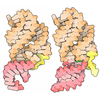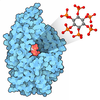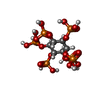[English] 日本語
 Yorodumi
Yorodumi- PDB-9b83: Cryo-EM structure of human ADAR1 in complex with dsRNA derived fr... -
+ Open data
Open data
- Basic information
Basic information
| Entry | Database: PDB / ID: 9b83 | ||||||
|---|---|---|---|---|---|---|---|
| Title | Cryo-EM structure of human ADAR1 in complex with dsRNA derived from human GLI1 gene | ||||||
 Components Components |
| ||||||
 Keywords Keywords | HYDROLASE/RNA / ADAR1-dsRNA complex / HYDROLASE-RNA complex | ||||||
| Function / homology |  Function and homology information Function and homology informationsomatic diversification of immune receptors via somatic mutation / negative regulation of post-transcriptional gene silencing by regulatory ncRNA / C6 deamination of adenosine / Formation of editosomes by ADAR proteins / supraspliceosomal complex / double-stranded RNA adenine deaminase / tRNA-specific adenosine deaminase activity / adenosine to inosine editing / negative regulation of protein kinase activity by regulation of protein phosphorylation / double-stranded RNA adenosine deaminase activity ...somatic diversification of immune receptors via somatic mutation / negative regulation of post-transcriptional gene silencing by regulatory ncRNA / C6 deamination of adenosine / Formation of editosomes by ADAR proteins / supraspliceosomal complex / double-stranded RNA adenine deaminase / tRNA-specific adenosine deaminase activity / adenosine to inosine editing / negative regulation of protein kinase activity by regulation of protein phosphorylation / double-stranded RNA adenosine deaminase activity / base conversion or substitution editing / response to interferon-alpha / hematopoietic stem cell homeostasis / negative regulation of hepatocyte apoptotic process / RISC complex assembly / pre-miRNA processing / definitive hemopoiesis / negative regulation of type I interferon-mediated signaling pathway / hepatocyte apoptotic process / carbohydrate transmembrane transporter activity / maltose binding / maltose transport / maltodextrin transmembrane transport / hematopoietic progenitor cell differentiation / positive regulation of viral genome replication / RNA processing / ATP-binding cassette (ABC) transporter complex, substrate-binding subunit-containing / protein export from nucleus / erythrocyte differentiation / PKR-mediated signaling / cellular response to virus / response to virus / mRNA processing / protein import into nucleus / osteoblast differentiation / Interferon alpha/beta signaling / double-stranded RNA binding / outer membrane-bounded periplasmic space / defense response to virus / innate immune response / nucleolus / mitochondrion / DNA binding / RNA binding / nucleoplasm / metal ion binding / nucleus / membrane / cytoplasm / cytosol Similarity search - Function | ||||||
| Biological species |   Homo sapiens (human) Homo sapiens (human) | ||||||
| Method | ELECTRON MICROSCOPY / single particle reconstruction / cryo EM / Resolution: 3.01 Å | ||||||
 Authors Authors | Deng, X. / Gao, Y. | ||||||
| Funding support |  United States, 1items United States, 1items
| ||||||
 Citation Citation |  Journal: Mol Cell / Year: 2025 Journal: Mol Cell / Year: 2025Title: Biochemical profiling and structural basis of ADAR1-mediated RNA editing. Authors: Xiangyu Deng / Lina Sun / Min Zhang / Rashmi Basavaraj / Jin Wang / Yi-Lan Weng / Yang Gao /  Abstract: ADAR1 regulates RNA-induced immune responses by converting adenosine to inosine in double-stranded RNA. Mutations in ADAR1 are associated with human autoimmune disease, and targeting ADAR1 has been ...ADAR1 regulates RNA-induced immune responses by converting adenosine to inosine in double-stranded RNA. Mutations in ADAR1 are associated with human autoimmune disease, and targeting ADAR1 has been proposed for cancer immunotherapy. However, the molecular mechanisms underlying ADAR1-mediated editing remain unclear. Here, we provide detailed biochemical and structural characterizations of human ADAR1. Our biochemical profiling reveals that ADAR1 editing is both sequence and RNA-duplex-length dependent but can well tolerate mismatches near the editing site. High-resolution ADAR1-RNA complex structures, combined with mutagenesis, elucidate RNA binding, substrate selection, dimerization, and the essential role of RNA-binding domain 3. The ADAR1 structures also help explain the potential defects of disease-associated mutations, where biochemical and RNA sequencing analysis further indicate some of the mutations preferentially impact the editing of RNAs with short duplexes. These findings unveil the molecular basis of ADAR1 editing and provide insights into its immune-regulatory functions and therapeutic potential. | ||||||
| History |
|
- Structure visualization
Structure visualization
| Structure viewer | Molecule:  Molmil Molmil Jmol/JSmol Jmol/JSmol |
|---|
- Downloads & links
Downloads & links
- Download
Download
| PDBx/mmCIF format |  9b83.cif.gz 9b83.cif.gz | 223.4 KB | Display |  PDBx/mmCIF format PDBx/mmCIF format |
|---|---|---|---|---|
| PDB format |  pdb9b83.ent.gz pdb9b83.ent.gz | 144.4 KB | Display |  PDB format PDB format |
| PDBx/mmJSON format |  9b83.json.gz 9b83.json.gz | Tree view |  PDBx/mmJSON format PDBx/mmJSON format | |
| Others |  Other downloads Other downloads |
-Validation report
| Summary document |  9b83_validation.pdf.gz 9b83_validation.pdf.gz | 1.5 MB | Display |  wwPDB validaton report wwPDB validaton report |
|---|---|---|---|---|
| Full document |  9b83_full_validation.pdf.gz 9b83_full_validation.pdf.gz | 1.5 MB | Display | |
| Data in XML |  9b83_validation.xml.gz 9b83_validation.xml.gz | 35.9 KB | Display | |
| Data in CIF |  9b83_validation.cif.gz 9b83_validation.cif.gz | 51.3 KB | Display | |
| Arichive directory |  https://data.pdbj.org/pub/pdb/validation_reports/b8/9b83 https://data.pdbj.org/pub/pdb/validation_reports/b8/9b83 ftp://data.pdbj.org/pub/pdb/validation_reports/b8/9b83 ftp://data.pdbj.org/pub/pdb/validation_reports/b8/9b83 | HTTPS FTP |
-Related structure data
| Related structure data |  44331MC  9b84C  9b89C M: map data used to model this data C: citing same article ( |
|---|---|
| Similar structure data | Similarity search - Function & homology  F&H Search F&H Search |
- Links
Links
- Assembly
Assembly
| Deposited unit | 
|
|---|---|
| 1 |
|
- Components
Components
| #1: RNA chain | Mass: 12563.527 Da / Num. of mol.: 1 / Source method: obtained synthetically / Source: (synth.)  Homo sapiens (human) Homo sapiens (human) | ||||||||
|---|---|---|---|---|---|---|---|---|---|
| #2: Protein | Mass: 165251.234 Da / Num. of mol.: 2 Source method: isolated from a genetically manipulated source Source: (gene. exp.)   Homo sapiens (human) Homo sapiens (human)Gene: malE, malE_1, A9X72_23600, ACN81_05700, ACU57_23670, AM464_13530, B6R31_000964, BANRA_05111, BCB93_001091, BF481_003801, BG944_002391, BGM66_004246, BJI68_06200, BJJ90_24825, BK292_00970, BTB68_ ...Gene: malE, malE_1, A9X72_23600, ACN81_05700, ACU57_23670, AM464_13530, B6R31_000964, BANRA_05111, BCB93_001091, BF481_003801, BG944_002391, BGM66_004246, BJI68_06200, BJJ90_24825, BK292_00970, BTB68_002078, BTQ06_17300, BvCmsKKP061_03224, BvCmsSIP010_04050, C0P57_003867, C1Q91_002164, C2R31_001890, C3F40_15210, C9E67_28370, CA593_05740, CF22_001770, CG692_11710, CG704_16590, CG831_003746, CIG67_12040, CQ986_003892, CR538_23895, CR539_01985, CTR35_003815, CV83915_02005, D4M65_12865, DIV22_28370, DNX30_07695, DS732_01860, DTL43_19585, E4K51_08355, E5H86_20640, E6D34_15030, EAI46_20350, EC95NR1_03574, ECs5017, EIZ93_13775, EN85_000970, EPS97_17355, ExPECSC038_04540, F9407_08085, F9461_21760, FIJ20_18085, FJQ40_13885, FOI11_015465, FOI11_20215, FPS11_04610, FV293_00135, FWK02_22115, G3V95_18070, G4A38_02205, G4A47_04495, G9448_13225, GAI89_05080, GAJ12_13200, GJ11_25475, GKF66_19285, GNW61_17855, GOP25_18965, GP965_07770, GP975_07695, GP979_10140, GQA06_09595, GQM04_22095, GQM21_08325, GRW05_14255, GRW24_12940, GRW56_08975, GRW57_10345, GUC01_08260, H0O72_20100, HEP30_015080, HHH44_003952, HLX92_13085, HMV95_14740, HV109_22180, HV209_20940, HVW43_14700, HVY77_23840, HX086_10250, HX136_23390, I6H00_16895, I6H02_15990, J0541_001933, J5U05_001620, JNP96_01525, KV259_002584, KV317_002918, KV371_002846, KV406_003109, KV449_002737, KV455_002759, KV463_002918, KV469_002607, KV499_002898, KV500_002927, NCTC10418_07064, NCTC10429_00012, NCTC10865_05806, NCTC11126_02082, NCTC11181_01902, NCTC12950_05149, NCTC13148_04480, NCTC4450_01671, NCTC8009_08341, NCTC8179_05034, NCTC8333_05503, NCTC8500_05253, NCTC8622_01707, NCTC8960_02276, NCTC8985_03950, NCTC9706_01951, NCTC9962_03706, NEP60_16880, O5851_07355, RG28_25590, SAMEA3752557_02201, TUM18780_41180, WR15_07725, ADAR, ADAR1, DSRAD, G1P1, IFI4 Production host:  Homo sapiens (human) Homo sapiens (human)References: UniProt: C3SHQ8, UniProt: P55265, double-stranded RNA adenine deaminase #3: Chemical | #4: Chemical | ChemComp-ZN / Has ligand of interest | Y | Has protein modification | N | |
-Experimental details
-Experiment
| Experiment | Method: ELECTRON MICROSCOPY |
|---|---|
| EM experiment | Aggregation state: PARTICLE / 3D reconstruction method: single particle reconstruction |
- Sample preparation
Sample preparation
| Component | Name: human ADAR1 in complex with dsRNA derived from human GLI1 gene Type: COMPLEX / Entity ID: #1-#2 / Source: MULTIPLE SOURCES |
|---|---|
| Molecular weight | Experimental value: NO |
| Source (natural) | Organism:  Homo sapiens (human) Homo sapiens (human) |
| Source (recombinant) | Organism:  Homo sapiens (human) Homo sapiens (human) |
| Buffer solution | pH: 7.5 |
| Specimen | Embedding applied: NO / Shadowing applied: NO / Staining applied: NO / Vitrification applied: YES |
| Vitrification | Cryogen name: ETHANE |
- Electron microscopy imaging
Electron microscopy imaging
| Microscopy | Model: FEI TECNAI 20 |
|---|---|
| Electron gun | Electron source:  FIELD EMISSION GUN / Accelerating voltage: 300 kV / Illumination mode: FLOOD BEAM FIELD EMISSION GUN / Accelerating voltage: 300 kV / Illumination mode: FLOOD BEAM |
| Electron lens | Mode: BRIGHT FIELD / Nominal defocus max: 2200 nm / Nominal defocus min: 600 nm |
| Image recording | Electron dose: 50 e/Å2 / Film or detector model: GATAN K3 (6k x 4k) |
- Processing
Processing
| EM software | Name: PHENIX / Version: 1.20.1_4487: / Category: model refinement | ||||||||||||||||||||||||
|---|---|---|---|---|---|---|---|---|---|---|---|---|---|---|---|---|---|---|---|---|---|---|---|---|---|
| CTF correction | Type: PHASE FLIPPING AND AMPLITUDE CORRECTION | ||||||||||||||||||||||||
| 3D reconstruction | Resolution: 3.01 Å / Resolution method: FSC 0.143 CUT-OFF / Num. of particles: 42348 / Symmetry type: POINT | ||||||||||||||||||||||||
| Refine LS restraints |
|
 Movie
Movie Controller
Controller




 PDBj
PDBj








































